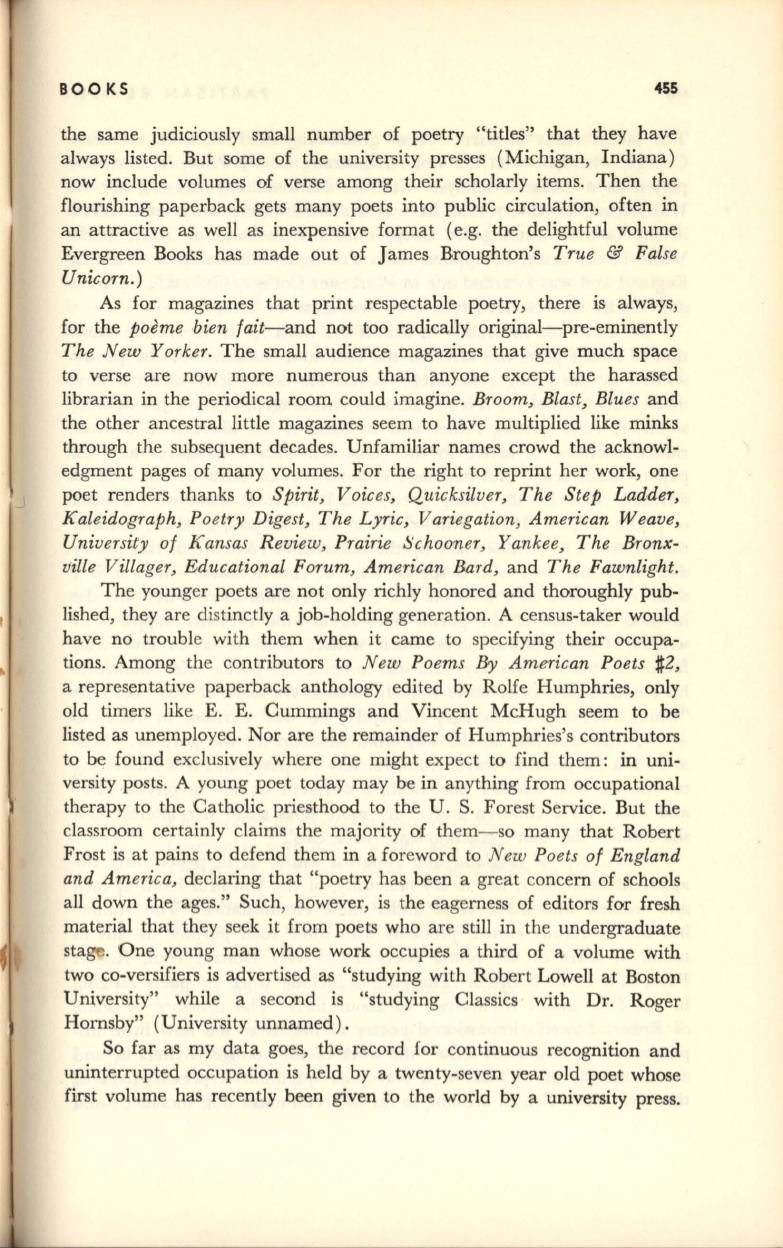
BOOKS
455
the same judiciously small number of poetry "titles" that they have
always listed. But some of the university presses (Michigan, Indiana)
now include volumes of verse among their scholarly items. Then the
flourishing paperback gets many poets into public circulation, often in
an attractive as well as inexpensive format (e.g. the delightful volume
Evergreen Books has made out of James Broughton's
True
&
False
Unicorn.)
As for magazines that print respectable poetry, there is always,
for the
poeme bien fait-and
not too radically original-pre-eminently
The New Yorker.
The small audience magazines that give much space
to verse are now more numerous than anyone except the harassed
librarian in the periodical room could imagine.
Broom, Blast, Blues
and
the other ancestral little magazines seem to have multiplied like minks
through the subsequent decades. Unfamiliar names crowd the acknowl–
edgment pages of many volumes. For the right to reprint her work, one
poet renders thanks to
Spirit, Voices, Quicksilver, The Step Ladder,
Kaleidograph, Poetry Digest, The Lyric, Variegation, American Weave,
University of Kansas Review, Prairie Schooner, Yankee, The Bronx–
ville Villager, Educational Forum, American Bard,
and
The Fawnlight.
The younger poets are not only richly honored and thoroughly pub–
lished, they are distinctly a job-holding generation. A census-taker would
have no trouble with them when it came to specifying their occupa–
tions. Among the contributors to
New Poems
By
American Poets #2,
a representative paperback anthology edited by Rolfe Humphries, only
old timers like E. E. Cummings and Vincent McHugh seem to be
listed as unemployed. Nor are the remainder of Humphries's contributors
to be found exclusively where one might expect to find them:
in
uni–
versity posts. A young poet today may be in anything from occupational
therapy to the Catholic priesthood to the U. S. Forest Service. But the
classroom certainly claims the majority of them-so many that Robert
Frost is at pains to defend them in a foreword to
New Poets of England
and America,
declaring that "poetry has been a great concern of schools
all down the ages." Such, however, is the eagerness of editors for fresh
material that they seek it from poets who are still in the undergraduate
stage. One young man whose work occupies a third of a volume with
two co-versifiers is advertised as "studying with Robert Lowell at Boston
University" while a second is "studying Classics with Dr. Roger
Hornsby" (University unnamed).
So far as my data goes, the record for continuous recognition and
uninterrupted occupation is held by a twenty-seven year old poet whose
first volume has recently been given to the world by a university press.


